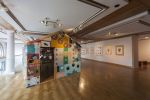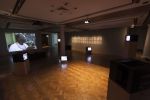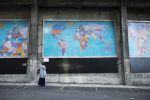The Hand Made Map of The World by Tam Joseph.
Super 8 footage of installation, Edinburgh 2014 ©Richard Hylton
Where do I end and you begin
Artists: Amar Kanwar, Antonia Hirsch, Arpita Singh, Brian Jungen and Duane Linklater, Derek Sullivan, Emma Rushton and Derek Tyman, Gavin Hipkins, Kay Hassan, Kushana Bush Mary Evans, Mary Sibande, Masooma Syed, Naeem Mohaiemen, Pascal Grandmaison, Rebecca Belmore, Shannon Te Ao, Shilpa Gupta, Steve Carr, Tam Joseph, Uriel Orlow, Yvonne Todd.
Curators: Thembinkosi Goniwe, Richard Hylton, Aaron Kreisler, Kathleen Ritter and Vidya Shivadas.
Taking its title from a work by Indian artist, Shilpa Gupta, the exhibition invites perspectives from across the Commonwealth to explore and interrogate the ideas, ideals and myths which underpin notions of community, common-wealth, and the commons.
Through new and recent work by over 20 international artists, Where do I end and you begin considers what it means to join ‘common’ with ‘wealth’, reflecting on the notion of The Commonwealth as a problematic historical and contemporary construct and offering international perspectives on the range of associations which common-wealth evokes, from the challenge of ‘being in common’ in a truly global world, to ideas of the common good, common land, public ownership and alternative exchange systems.
More +
Making History
In Beyond A Boundary, […], Trinidadian writer C.L.R. James argued that the rituals and spectacle of that most colonial of sports, cricket, were essentially a reflection of wider society. For James what went on in the field of play was itself a microcosm of what went on beyond the boundary. One of many examples cited by James was England’s legendary Ashes tour of Australia in 1932. This tour was significant because the England team devised a tactic of bowling deliveries aimed towards the batsman’s body rather than the wicket. Known as ‘bodyline’, this tactic was considered physically intimidating and ‘unsporting’ behaviour. Reflecting on the significance of the ‘bodyline’ tour James writes:
"Bodyline was not an incident, it was not an accident, and it was not a temporary aberration. It was the violence and ferocity of our age expressing itself in cricket. The time was the early thirties, the period in which the contemporary rejection of tradition, the contemporary disregard of means, the contemporary callousness, were taking shape. The totalitarian dictators cultivated brutality of set purpose. By now all of us have supped full with horrors. Today cruelties and abominations, which would have immeasurably shocked and permanently distressed earlier ages are a commonplace." [C.L.R James, Beyond A Boundary, Yellow Jersey Press, London, 2005 edition, 248].
For James, the brutality and devastation of the First World War would eventually infiltrate the 1930s cricket field. The 1930s also saw the emergence of the British Empire Games. Like cricket, the British Empire Games, were very much a product of British imperial ambition and global dominance. Yet, unlike cricket, the British Empire Games emerged during the Empire’s decline and, were not so much a microcosm of the British Empire but more a projection of its mythology. Within this context it still seems almost implausible that a legacy of subjugation, colonial expansion, annexation and exploitation could have produced a misnomer such as the Commonwealth, let alone such an enduring sporting event.
Over the course of its eighty-year existence, the Commonwealth Games has undergone various name changes. Originally called the British Empire Games at its inception in 1930, it became the British Empire and Commonwealth Games in 1954, then the British Commonwealth Games in 1970. Its moniker was further truncated in 1978, to the one by which it is still known today. Although only so much can be read in a name, such changes reflect, above all else, the extent to which the world and, perhaps more significantly, Britain’s position within it has changed.
Once the product of Britain’s global influence and dominance, today the Commonwealth Games exists in a very different world, one dominated and shaped by modern forces of globalisation, as well as the economic rise of countries such as Brazil, India and China which challenge the West’s capitalist hegemony. Today’s Commonwealth espouses a set of ethical values which might seem at odds with economic and political systems, which valorize and champion not so much a common wealth but private wealth (privatisation). The values espoused by the Commonwealth today may be viewed as contrasting sharply with the realities of the ‘free market’. Equally, despite advocating seemingly benign values, the Commonwealth itself also harbours a certain paradox, in that its own roots, colonisation and exploitation, could be argued, to be the progenitor of today’s ‘free market’.
Within the context of the 2014 Commonwealth Games, the concept of the Commonwealth and a common-wealth, are starting points for reflecting and scrutinising issues and ideas, which challenge, probe and question concepts of, history, legacy, culture, community and identity. Furthermore, the Scottish Independence referendum 2014 provides another context in which to examine both historical and contemporary ideas around national identity and nationalism.
The UK-based artists selected for the exhibition Where do I end and you begin are Mary Evans, Uriel Orlow, Tam Joseph, and Emma Rushton and Derek Tyman. The initial brief presented by Edinburgh Art Festival could itself have elicited a number of possible artists. However, the process of actually visiting Edinburgh’s many different art and cultural institutions, including the National Museum of Scotland, Edinburgh’s Royal Botanic Gardens, and experiencing the particularity of the ‘festival time’ and as well as the City Art Centre, has contributed, to the nature of my selection…
Where do I begin and you end
128pp, ISBN 0992990904
City Art Centre
1 August – 19 October 2014
Part of the Glasgow 2014 Cultural Programme, and during the year of Homecoming Scotland, Edinburgh Art Festival in partnership with City Art Centre presented a major international exhibition of contemporary art selected by five curators from Commonwealth countries.



